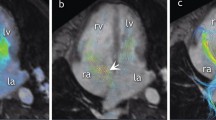Summary
The aim of this study was to compare the results of magnetic resonance based shunt volume measurements with the results of the invasive method by the principle of Fick. In 14 children (median age: 16.5 months) with ventricular septal defects the shunt volume was quantified by magnetic resonance flow measurements under spontaneous breathing conditions as well as with invasive angiography during one sedation. A good correlation between both methods was observed (r2 = 0.8, p <0.0001, CI95% = 0.62–1.22). A tendency towards higher values in the noninvasive technique was found in the Bland-Altman plot (bias = 3.79). Magnetic resonance based shunt measurements are a reliable alternative to the invasive shunt measurement by cardiac catheterization.
Similar content being viewed by others
References
Abolmaali ND, Esmaeili A, Feist P, Ackermann H, Requardt M, Schmidt H, Vogl TJ (2004) Reference Values of MRI Flow Measurements of the Pulmonary Outflow Tract in Healthy Children. RöFo Fortschr Geb Rontgenstr Neuen Bildgeb Verfahr 176:837–845
Beerbaum P, Korperich H, Barth P, Esdorn H, Gieseke J, Meyer H (2001) Noninvasive quantification of left–toright shunt in pediatric patients: phase–contrast cine magnetic resonance imaging compared with invasive oximetry. Circulation 103:2476– 2482
Beerbaum P, Korperich H, Gieseke J, Barth P, Peuster M, Meyer H (2003) Rapid left–to–right shunt quantification in children by phase–contrast magnetic resonance imaging combined with sensitivity encoding (SENSE). Circulation 108:1355–1361
Bernstein MA, Zhou XJ, Polzin JA, King KF, Ganin A, Pelc NJ, Glover GH (1998) Concomitant gradient terms in phase contrast MR: analysis and correction. Magn Reson Med 39:300–308
Boehrer JD, Lange RA, Willard JE, Grayburn PA, Hillis LD (1992) Advantages and limitations of methods to detect, localize, and quantitate intracardiac left–to–right shunting. Am Heart J 124:448–455
Brenner LD, Caputo GR, Mostbeck G, Steiman D, Dulce M, Cheitlin MD, O’Sullivan M, Higgins CB (1992) Quantification of left to right atrial shunts with velocity–encoded cine nuclear magnetic resonance imaging. J Am Coll Cardiol 20:1246–1250
Doll U, Herberg U, Tiemann K, Schirrmeister J, Bernhardt C, Köhler W, Schmitz C, Breuer J (2005) Ruptured sinus of Valsalva aneurysm in two patients with subarterial ventricular septal defect. Clinical Research in Cardiology 95:127–131
Ewert P, Kretschmar O, Peters B, Abdul Khaliq H, Nagdyman N, Schulze– Neick I, Bass J, Le TP, Lange PE (2004) Interventioneller Verschluss angeborener Ventrikelseptumdefekte: Breitere Indikationsstellungen dank neuer Implantate. Zeitschrift für Kardiologie 93:147–155
Fyler DC (1992) Nadas Pediatric Cardiology. Hanley & Belfus, Inc., Philadelphia, Mosby Yearbook Incorporation, St Louis, pp 435–457
Gorenflo M, Bettendorf M, Ulmer HE, Brockmeier K (2000) Oxygenmediated pulmonary vasodilation and plasma levels of endothelin–1, atrial natriuretic peptide and cyclic GMP in patients with left–to–right shunt and pulmonary hypertension. Zeitschrift für Kardiologie 89:100–108
Higgins CB, Byrd BF, McNamara MT, Lanzer P, Lipton MJ, Botvinick E, Schiller NB, Crooks LE, Kaufman L (1985) Magnetic resonance imaging of the heart: a review of the experience in 172 subjects. Radiology 155:671–679
Hinterseer M, Becker A, Barth AS, Kozlik–Feldmann R, Wintersperger BJ, Behr J (2006) Interventional embolization of a giant pulmonary arterio–venous malformation with right–left–shunt associated with hereditary hemorrhagic telangiectasia. Clinical Research in Cardiology 95:174–178
Hundley WG, Li HF, Lange RA, Pfeifer DP, Meshack BM, Willard JE, Landau C, Willett D, Hillis LD, Peshock RM (1995) Assessment of leftto– right intracardiac shunting by velocity– encoded, phase–difference magnetic resonance imaging. A comparison with oximetric and indicator dilution techniques. Circulation 91:2955–2960
Kalden P, Kreitner KF, Voigtlander T, Roberts H, Roberts T, Krummenauer F, Becker D, Wittlinger T, Meyer J, Thelen M (1998) Flow quantification of intracardiac shunt volumes using MR phase contrast technique in the breath holding phase. Rofo Fortschr geb rontgenstr Neuen Bildgeb Verfahr 169:378–382
Korperich H, Gieseke J, Barth P, Hoogeveen R, Esdorn H, Peterschroder A, Meyer H, Beerbaum P (2004) Flow volume and shunt quantification in pediatric congenital heart disease by real–time magnetic resonance velocity mapping: a validation study. Circulation 109:1987–1993
Lotz J, Meier C, Leppert A, Galanski M (2002) Cardiovascular flow measurement with phase–contrast MR Imaging: basic facts and implementation. Radiographics 22:651–671
Li LB, Kai M, Kusama T (2001) Radiation exposure to patients during pediatric cardiac catheterisation. Radiat Prot Dosimetry 94(4):323–327
Moran PR (1982) A flow velocity zeugmatographic interlace for NMR imaging in humans. Magn Reson Imaging 1:197–203
Perlmutt LM, Braun SD, Newman GE (1987) Pulmonary arteriography in the high–risk patient. Radiology 162:187–189
Peters B, Ewert P, Schubert S, Abdul– Khaliq H, Schmitt B, Nagdyman N, Berger F (2006) Self–fabricated fenestrated Amplatzer occluders for transcatheter closure of atrial septal defect in patients with left ventricular restriction: midterm results. Clinical Research in Cardiology 95:88–92
Powell AJ, Tsai–Goodman B, Prakash A, Greil GF, Geva T (2003) Comparison between phase–velocity cine magnetic resonance imaging and invasive oximetry for quantification of atrial shunts. Am J Cardio 91:1523–1525
Sakuma H, Kawada N, Kubo H, Nishide Y, Takano K, Kato N, Takeda K (2001) Effect of Breath Holding on Blood Flow Measurement Using Fast Velocity Encoded Cine MRI. MRM 45:346–348
Schmalz AA, Schaefer M, Hentrich F, Neudorf U, Brecher AM, Asfour B, Urban AE (2004) Ventrikelseptumdefekt und Aorteninsuffizienz: Pathophysiologische Aspekte und therapeutische Konsequenzen. Zeitschrift für Kardiologie 93:194–200
Schumacher G, Bühlmeyer K (1987) Diagnostik angeborener Herzfehler. Band 1: Allgemeiner Teil: Untersuchungsmethoden. Perimed Verlag, Erlangen, pp 161–162
Stoermer J, Hentrich F, Galal D (1984) Risiken der Herzkatheterisierung und Angiokardiographie in Säuglingen und im Kindesalter. Klin Pädiatr 196:191–194
Author information
Authors and Affiliations
Corresponding author
Rights and permissions
About this article
Cite this article
Esmaeili, A., Höhn, R., Koch, A. et al. Assessment of shunt volumes in children with ventricular septal defects:. Clin Res Cardiol 95, 523–530 (2006). https://doi.org/10.1007/s00392-006-0415-6
Received:
Accepted:
Published:
Issue Date:
DOI: https://doi.org/10.1007/s00392-006-0415-6




